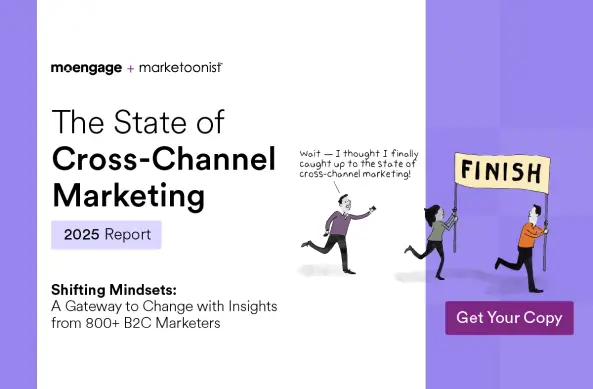Perfecting Personalization in Media Marketing: What It Is + Top Examples
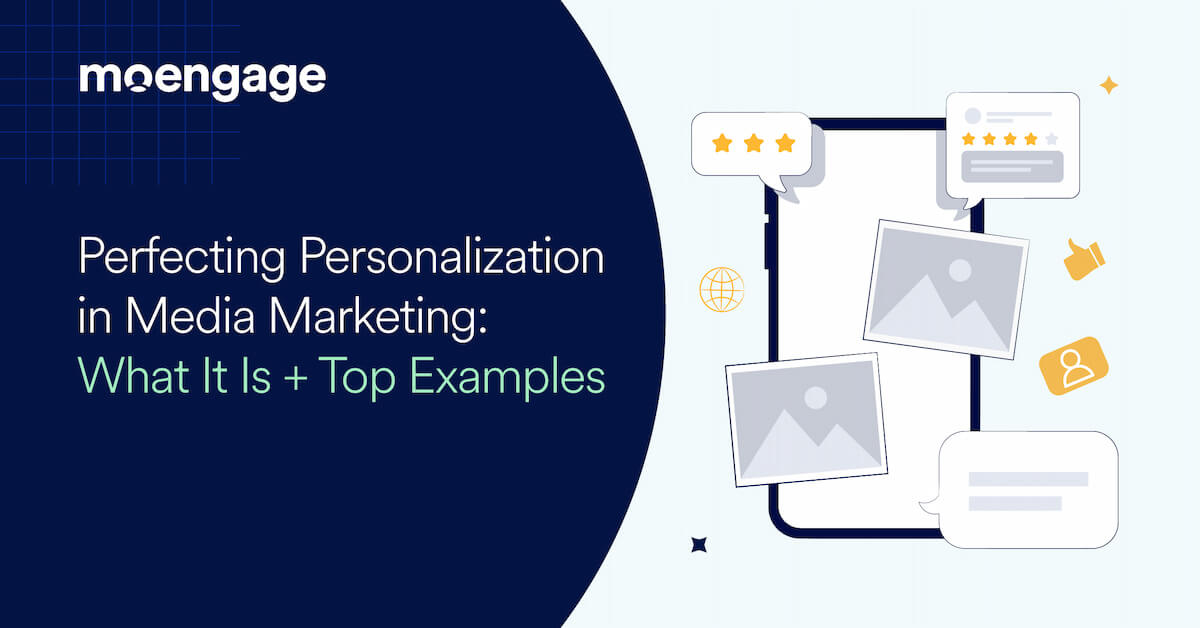
Reading Time: 7 minutes
Imagine this: you’re scrolling through your favorite streaming platform, looking for something new to watch. Suddenly, a recommendation pops up that feels like it was made just for you.
It’s as if the platform knows your taste in movies and TV shows better than you do.
That’s the power of personalization.
In the exciting world of media and entertainment, connecting with your audience is the key to success. It’s about more than just marketing — it’s about creating an experience that resonates with customers and keeps them coming back for more.
Personalized marketing goes beyond just delivering a great experience. It’s about building a relationship with your customers, understanding their preferences, and tailoring your messaging to meet their needs.
According to our Personalization Pulse Check Report, a staggering 58% of North American consumers are frustrated with brands that offer generic and inconsistent communication. In today’s competitive landscape, that’s a risk you can’t afford to take.
By using personalization techniques effectively, media and entertainment brands can perfect their marketing efforts. They can create targeted customer journey-based campaigns that speak directly to their audience, increasing customer satisfaction and engagement. And it’s not just about attracting new customers — it’s about retaining them too.
When customers receive tailored messaging that speaks to their interests and preferences, they’re more likely to engage with your brand over and over again.
So, how can you use personalization to take your media marketing to the next level?
Here, we’ll explore that and more, diving into strategies and best practices that will help you drive customer engagement, boost retention, and ultimately, achieve success in this ever-evolving industry.
Let’s dive in.
What is Personalization in Media Marketing?
Personalization in media marketing is a customer engagement strategy that involves customizing experiences. It’s built on targeted communication that’s sent through the right channels, at the right time and frequency, to resonate with individual customers.
According to our recent survey, 40% of media and entertainment marketers are customizing communications for different stages of the customer journey.
As such, for media and entertainment companies, personalization is all about driving traction that leads to increased engagement, retention, time in-app, subscriptions/conversions, and revenue. Efforts should be focused on sharing relevant content recommendations, curating custom experiences, serving targeted advertisements, and optimizing campaigns.
7 Benefits of Personalization in Media Marketing
As we’ve established earlier, hyper-personalized marketing can help media brands deliver communication and experiences that resonate with their audience. Here are the benefits you can reap from implementing personalization in your engagement campaigns:
- Serve customized ads for engagement and re-engagement: Contextually relevant ads get more views, have higher click-through rates, and ultimately lead to more conversions.
- Create memorable experiences that customers love: Tailored marketing materials that resonate with your customers grab their attention, keep them interested in your service, and build relationships based on brand loyalty.
- Nurture leads effectively via the optimal pathway: Communicate with customers at the right time via their preferred channels to strategically guide customers in their buying journey toward a successful conversion.
- Provide contextually relevant content & recommendations: Curate content recommendations based on customer preferences, habits, behaviors (such as browsing history and past purchases), and activities.
- Foster customer loyalty and increase customer lifetime value (LTV): Nurture deep, authentic relationships that increase customer lifetime value and lead to brand advocacy.
- Activate dormant or inactive customers: Send hyper-personalized messages to engage viewers, listeners, or readers with high churn risk, or reactivate those who have gone dormant by motivating them to renew their subscriptions.
- Cross-sell and upsell effectively: Provide relevant content and product/service recommendations that are far more likely to garner an upsell or cross-sell.
Ultimately, these benefits all help work towards the goal of increasing customer engagement.
Below, we use examples from leading brands to look at how media marketers can implement various personalization strategies to win the hearts of their customers.
6 Cross-Channel Personalized Media Marketing Examples to Increase Customer Retention
Effectively executing a personalized media marketing campaign is extremely challenging, requiring teams to perfect many different processes, from data collection and analysis to campaign planning. Organizations need to marshal detailed consumer information and behavioral data to understand and predict customer interests and preferences.
However, looking at real-life examples of leading brands in the industry can provide creative inspiration and help you learn best practices. Below, we cover some of the best real-life examples of personalized media marketing strategies from leading media brands.
1. Netflix’s in-app and on-site content recommendations
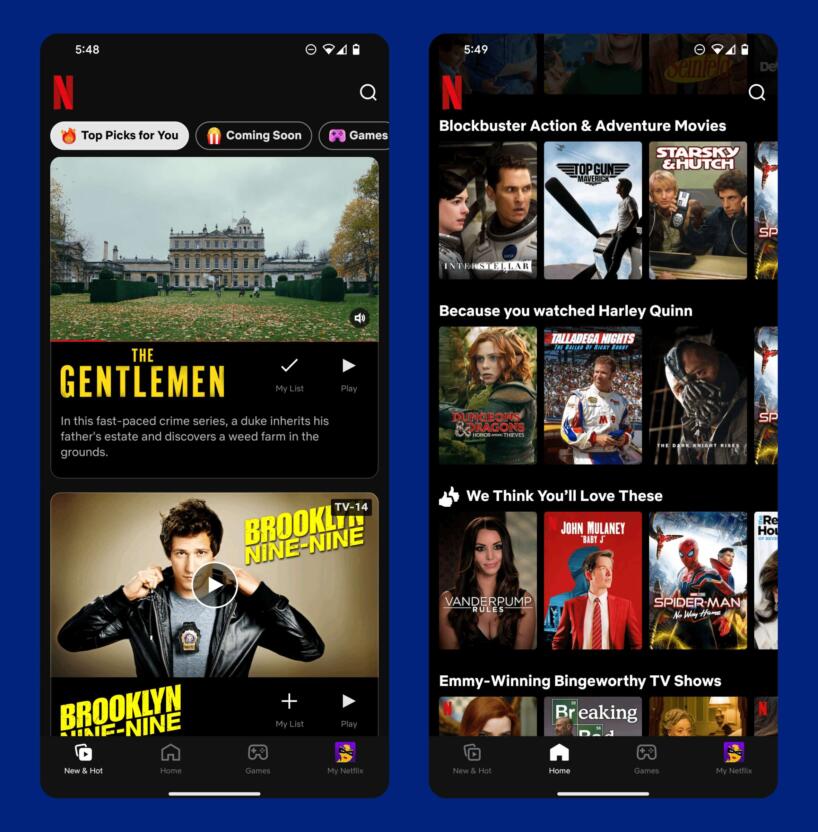
Media marketers these days know the pulse of their customers and hence focus on prioritizing personalization. As per our North American Personalization Pulse Check Report, 28% of consumers want brands to personalize their experience using purchase history. However, Netflix goes even deeper with personalized recommendations, creating fully curated lists that are customized to the individual subscriber.
For example, the “Because you watched” filter lists content that’s directly related to a particular movie or series you’ve watched. Similarly, the “Top Picks For You” and “We Think You’ll Love These” categories are curated lists of content that Netflix believes you’re most likely to enjoy based on your previous viewing history, your reviews or ratings of movies and shows, bookmarked content, and general in-app activity.
Netflix also offers generically filtered lists, like “Blockbuster Action & Adventure Movies,” “Comedy Movies,” and many more that are personalized based on the viewer’s preferences. The categories you’ve frequently watched are prioritized, so you see them higher.
Providing customers with the content they want — and saving them time when searching for it — drastically increases engagement and (most importantly) retention.
2. Spotify’s targeted mobile push notification campaigns
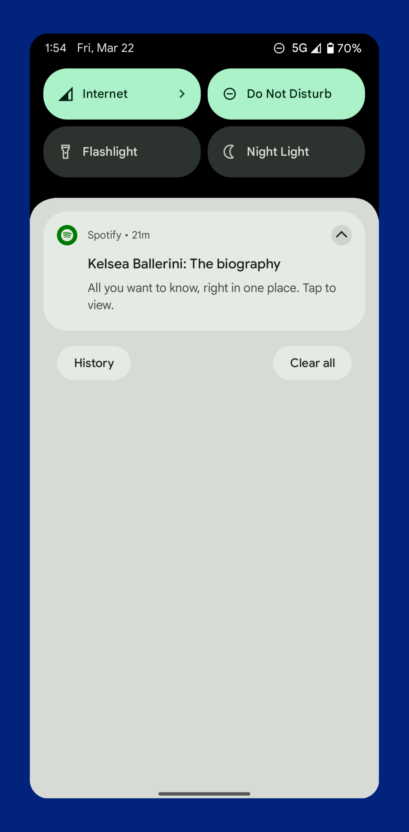
Marketing isn’t just about driving an immediate conversion. It’s also about building meaningful, long-lasting relationships with customers through continuous engagement.
Spotify triggers mobile push notifications based on recent customer activity. After a listener hears a new artist for the first time, Spotify triggers a mobile push notification that advertises that artist’s biography page, motivating them to learn more about that artist, and potentially even follow their page. This increases listening time, time spent in-app, and — ultimately — subscriptions (and LTV).
3. PGA TOUR’s streamlined, customized user experiences
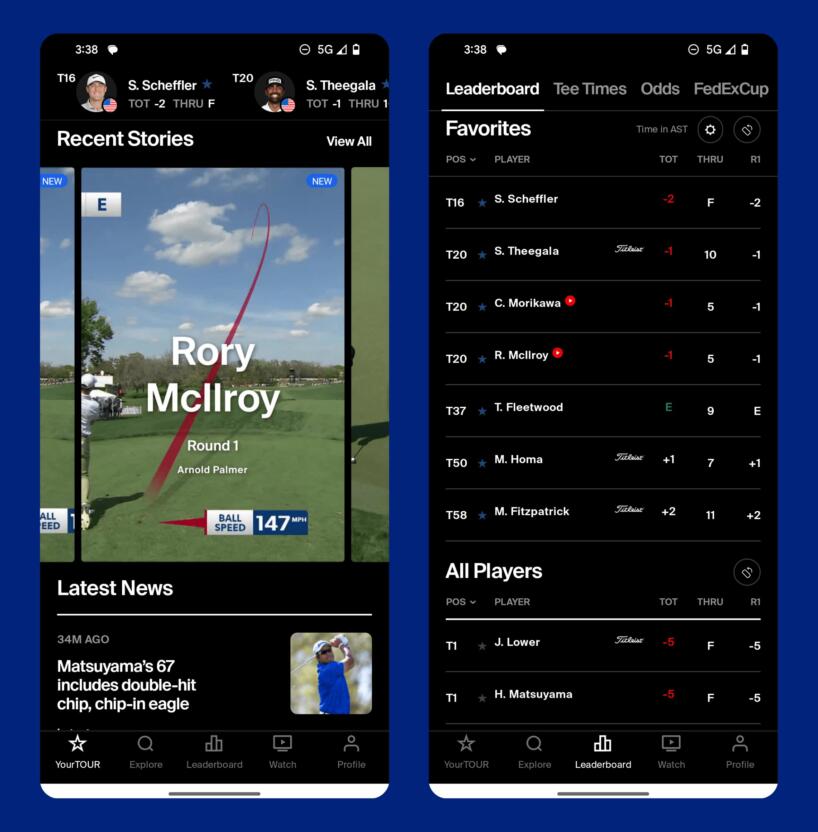
The PGA Tour uses app insights to understand which golfers the viewers are most interested in, helping them improve their broadcasts. They can also directly drive app viewers to subscribe to broadcasts or attend live events, by adding customized CTA banners on the app.
App user interface and experience are core components of stickiness and retention, especially when it comes to media and entertainment consumption. That’s why the PGA Tour’s entire in-app experience is designed to deliver the content consumers care about most (as quickly, easily, and efficiently as they can). It does so by curating videos, leaderboards, and news articles based on the players they’re most interested in.
Offering a fully customized experience that provides customers with the content they want most drastically improves app stickiness, engagement, retention, and LTV.
4. Google Play Books’ mobile push notifications with targeted discounts
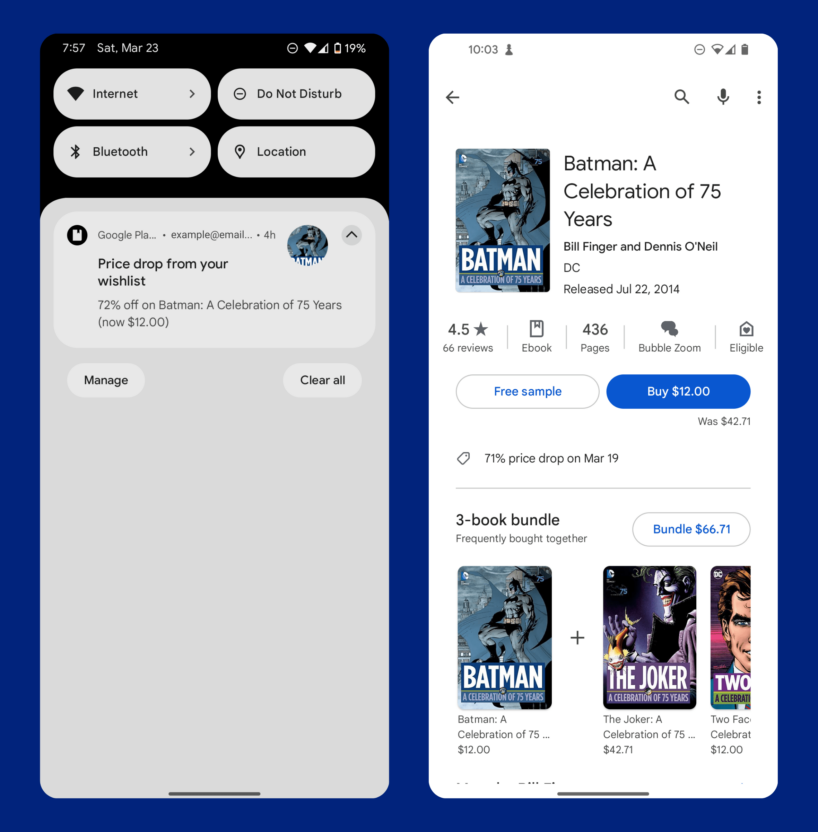
Discounts and promotions are commonly used to entice new consumers or upsell existing customers. Our recent survey of North American consumers found that 18% of respondents said that getting personalized discounts and coupons delighted them the most about a brand experience. However, offering irrelevant discounts can result in wasted resources and expenses for your marketing team.
Google Play Books uses personalized push notifications to send personalized offers for books and reading materials that customers have already shown interest in. This not only improves the customer experience by providing relevant recommendations and limited-time offers, but it also significantly boosts conversion rates by serving offers related to products and content the customers are already interested in.
5. Cineplex drives conversions with personalized email marketing
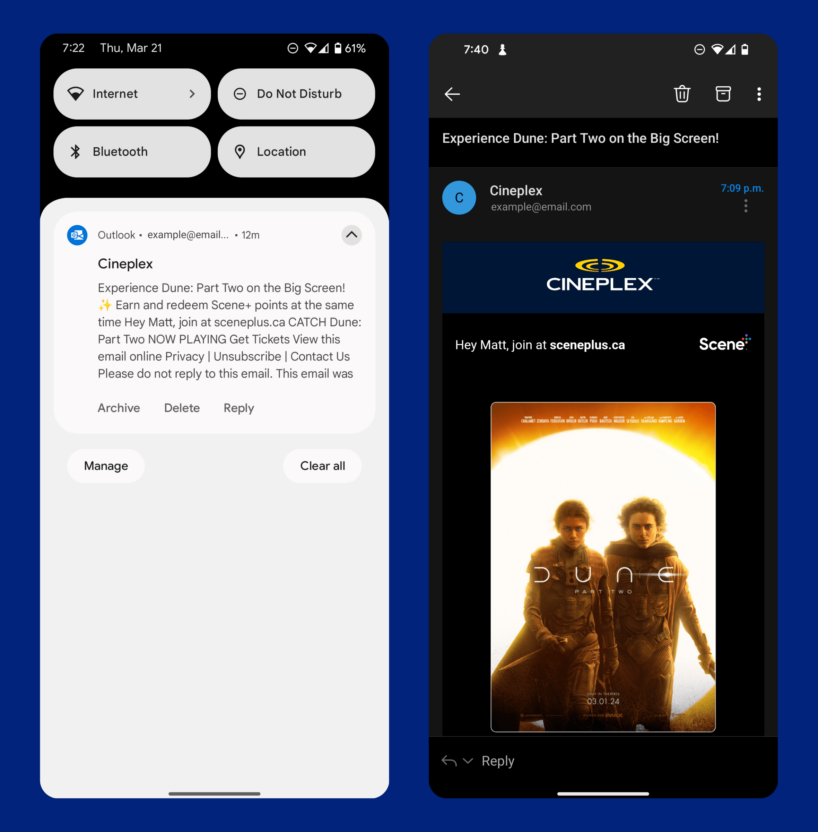
Email personalization is often — rightfully — used to craft experiences that increase satisfaction and engagement. But, when applied effectively, it can be used to drive conversions and revenue.
Cineplex sends targeted email campaigns that recommend upcoming films, factoring in customer behavior data. By using previous viewing and purchase history, they’re able to recommend content that customers are more likely to be interested in.
In this case, since the customer previously ordered tickets for Dune through the app, Cineplex automatically triggered a recommendation when the second film in the series came to theaters.
At the end of the day, leveraging customer data allows marketers to offer highly relevant recommendations, across channels, that lead to higher conversion rates.
6. Netflix reactivates dormant customers with targeted content recommendations
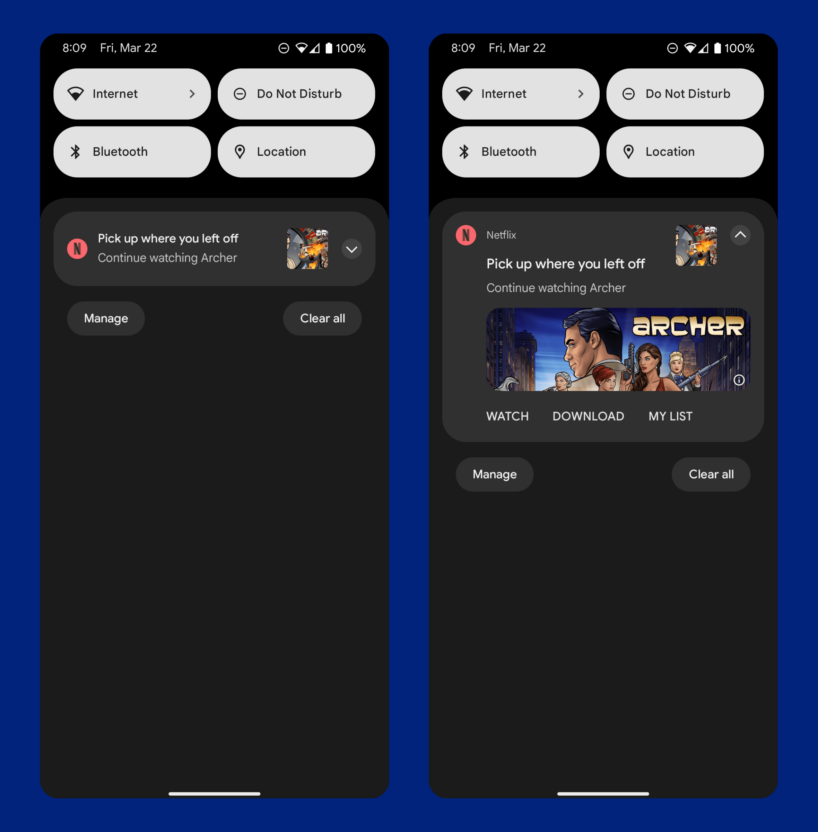
When it comes to reactivating dormant customers, using the right kind of communication is crucial. Netflix understands the importance of personalized engagement and leverages it to bring back customers who have become disengaged.
Netflix employs a strategic approach by sending personalized push notifications and emails to notify customers about new content that aligns with their interests. These recommendations are based on the viewer’s previous activity, ensuring a tailored and relevant experience.
By alerting customers to new episodes and content they are likely to be interested in, Netflix makes it easy for them to return and resume their viewing experience. This focused content recommendation not only enhances the user experience but also has the potential to reactivate dormant customers.
The power of relevant and timely content recommendations cannot be underestimated. By leveraging targeted communication, Netflix significantly increases customer engagement, time spent in-app, and subscriptions.
Mastering Personalized Media Marketing with MoEngage
Unlike other industries where customer acquisition is the main objective, media and entertainment companies are more concerned with increasing engagement and loyalty. After all, this leads to more time in-app, content consumption, subscriptions, and revenue.
One of the best ways to achieve this is by offering customers uniquely personalized experiences and communication that they resonate with and find value in, so that they keep coming back.
MoEngage’s Customer Engagement platform is designed to help teams hyper-personalize all aspects of your media marketing efforts for greater impact and improved retention, across channels and throughout the entire customer journey.
Schedule a demo today to learn how we can help you with the right customer insights and personalization capabilities to perfect your media marketing strategy.

